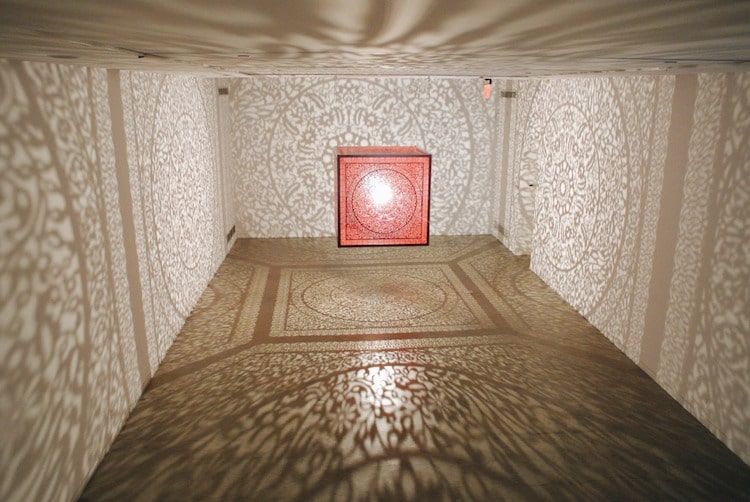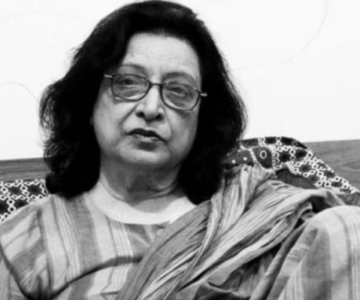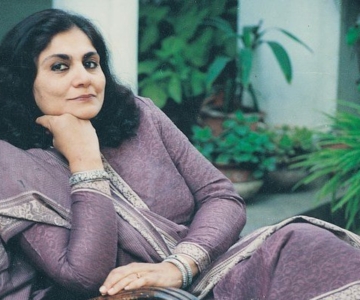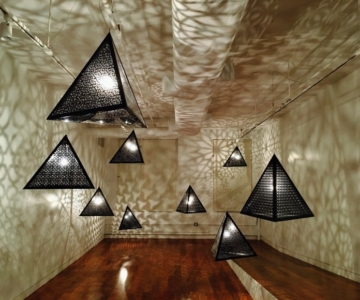January 22, 2017: The personal is political (Dawn)
Pakistani American artist Anila Quayyum Agha has been celebrated for her groundbreaking sculptural installation ‘Intersections’ that earned her global acclaim and resonated with a host of cultures. Her recently concluded exhibition “Walking with My Mother’s Shadow” at Aicon Gallery, New York, weaved even more personal, intimate stories. Agha’s work has a universal appeal. With a range of drawings and installations, the artist presented mixed emotions of celebrating her son’s wedding and mourning the loss of her mother which occurred within a gap of few weeks in the early part of 2016. These contradictory experiences in effect narrate a lived experience. In an interview, Agha stated that her current work “reflects on the complexities of love, loss and gains.” It is this juxtaposition of the personal with the political, and meditation on the past and the future that defines and sharpens the emotive appeal of her work.
The current show employs a range of media, from large embroidered drawings to sculptural installations, which investigate the complex relationships between religion, gender and culture. Her engagement with the political is clear in the works that were displayed at the gallery. But the personal anguish and reflection is what strikes the viewer. The reflection of light and darkness expands the scope of viewer’s experience and also brings him / her into the artistic narrative.
Agha’s consciousness of [in] justice is rooted in her personal history and during the conversation, she recounted the obstacles that she had to face as a young woman and over time her meditations on gender and culture have crystallised and informed her practice.
Anila Quayyum Agha’s work investigates the complex relationships between religion, gender and culture
The floral patterns, cuts and embroidery that recur in the show are attempts to capture “the identity, beauty, and femininity of my mother and other mothers — me, you, and us — that become obscured by gravestone and shroud,” she said. The funeral and the wedding that led to the show pay homage to the cycle of life encompassing both beauty as well as fragility.
Agha explains the use of embroidery and beads on white, black and brown paper that “reflects and refracts light … represent space that belongs to one more than the other, evaluate the colour of my body and the bodies of others, and the cycles of life and death.” Conversely, the black drawings featured in the exhibition denote both the surface and the hidden layers “often not seen or mined.” Her drawings in brown drawings highlight “our bodies, and the longing to belong and matter.” The red and black sculptural installations amplify floral and geometric motifs “to inhabit a large space, covering and beautifying all that are in it.”
The series “The Regeneration” was inspired by the immense efforts of women in fixing homes and countries, says Agha. Man-made disasters are ultimately handled by women and they regenerate the earth as well as human dwellings.
Agha’s piece de resistance ‘Intersections’ played with the geometrical patterns inherent to Islamic sacred spaces, and despite the certitude of the belief system, it articulates fluidity of spiritual representation and experience. The installation draws in the viewer “to confront the contradictory nature of all intersections, while simultaneously exploring boundaries.”
Inspired by her memory of Lahore where she grew up, the mosques “filled with bouquets of calligraphic writing and geometric symmetry” interact with the devotees. However, most mosques are not open to women. The notion of exclusion from a public space came back to Agha when she visited the Moorish Spain. At Alhambra she saw the wonderment in the eyes of the visitor and this complicated emotion inspired ‘Intersections’. Here Agha celebrates the geometric depth of Alhambra, but also the “intersection of history, culture and art” and the conflation as well as symbiosis of Islamic and Western discourses.
‘Intersections’, most notably, suggests visual experience where the shadows, ambiguities and dark spaces exist despite the harmony and open up the range of possibilities within the Muslim cultures of past and the present. At the same time the single source of light emphasises the unity but creates shadows which are under nobody’s control.
The rich corpus of Agha’s practice underlines her highly evolved skill in drawing but also the outstanding ability to think and speak beyond and beneath the lines. “Walking with My Mother’s Shadow” is also a conversation by the artist with her past and present and exploration of identity, loss and abounding confidence in life.
The show “Walking with My Mother’s Shadow” was held at the Aicon Gallery, New York, from October 20 to December 3, 2016.



